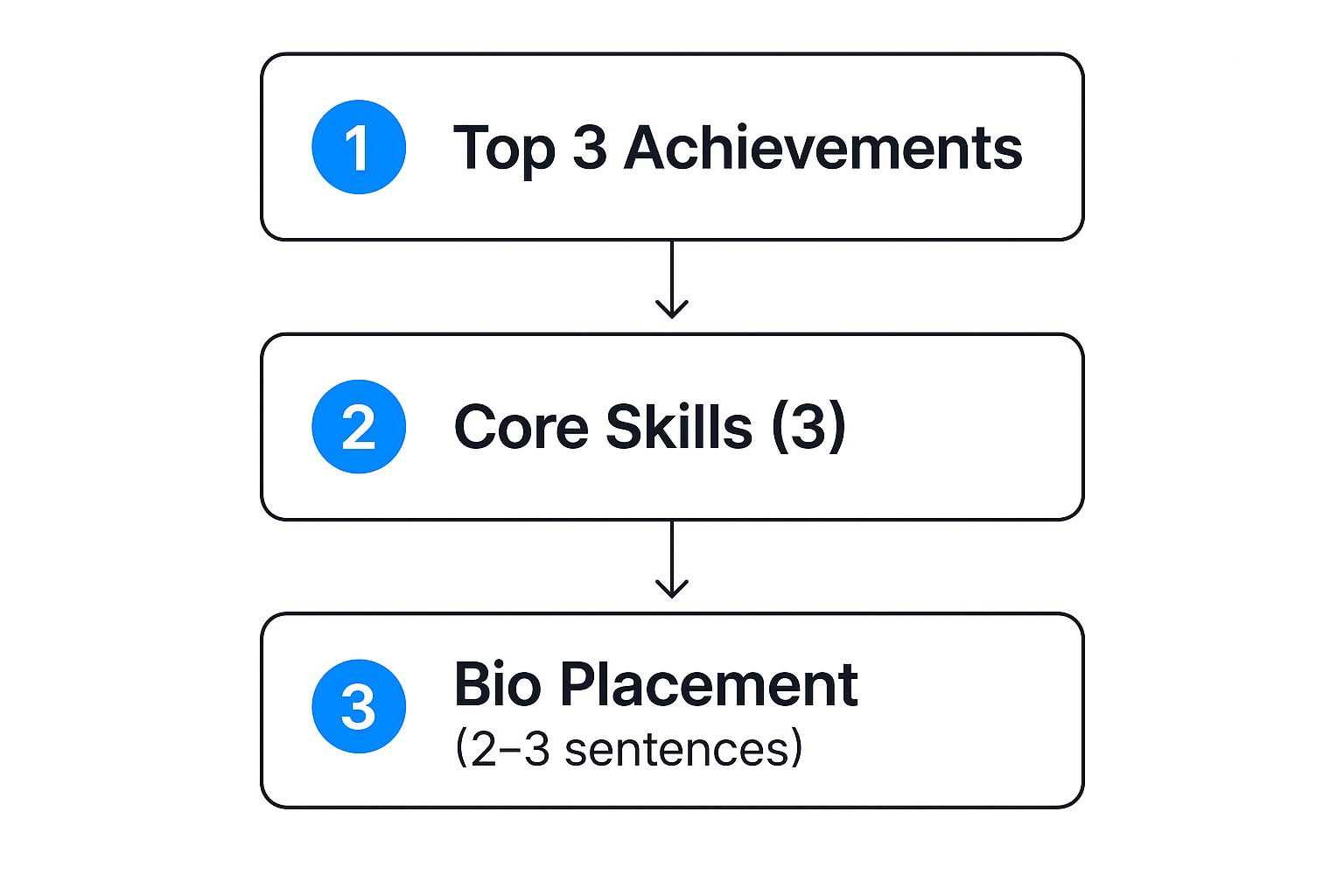How to Write a Bio That Truly Stands Out

Let's be honest: writing about yourself is hard. It can feel awkward, a little boastful, or just plain impossible to boil your entire professional life down into a few short paragraphs.
But here's the thing: in a world where first impressions happen online, your bio is one of the most strategic assets you have. It's so much more than a summary of your resume—it's your personal brand, distilled.
A well-crafted bio works for you 24/7. It's your digital handshake, introducing you to potential clients, employers, and collaborators long before you ever meet them. It frames your expertise, builds immediate trust, and makes you memorable in a sea of faces. Think of it as the secret weapon that unlocks professional opportunities, even when you aren't in the room.
From Chore to Opportunity
The real trick to learning how to write a bio that actually works is shifting your mindset. Instead of seeing it as a tedious chore, view it as your chance to take control of your own narrative. This is your platform to connect your accomplishments to your personality and your mission.
A smart approach always starts with identifying your goals and audience. You need to know where the bio will live and what you need it to do—whether that's generating leads, building industry authority, or just making a genuine connection. It's not just fluff; data from platforms like LinkedIn shows that profiles with fleshed-out bios can receive up to 40% more opportunities. This proves that a little structure and strategy go a long way. You can explore a detailed breakdown of this strategic approach to learn more about defining your bio's purpose.
Key Takeaway: A great bio isn't just a list of facts. It's a persuasive story designed to connect with a specific audience and achieve a clear professional goal.
Putting a little time into this critical piece of your professional identity pays off big time. It ensures that when someone searches your name, they find a confident, compelling, and authentic story that you wrote yourself—setting the stage for everything that follows.
Laying The Groundwork For A Powerful Bio
Before a single word hits the page, the real work begins. It’s this strategic prep that separates a generic, forgettable bio from one that genuinely connects with people and gets results. Think of it as building the foundation for your personal brand.
The very first place to start? Your audience. Who are you actually writing this for? A bio crafted for potential clients on your business website will have a completely different feel than one for recruiters on LinkedIn or your peers at a conference.
Understanding your reader is everything. It shapes your tone, the stories you choose to tell, and which accomplishments you decide to feature.
Clarify Your Core Message And Goal
Once you know who you’re talking to, you need to get crystal clear on your bio's main purpose. What's the one thing you want someone to think, feel, or do after reading it?
Is your goal to:
- Drive business inquiries? In that case, your bio should scream "problem-solver" and showcase client results.
- Catch a recruiter's eye? Focus on your career trajectory, key skills, and especially those quantifiable achievements.
- Build your industry authority? This is where you'll want to highlight speaking gigs, publications, and your unique point of view.
This single, focused goal becomes your north star, keeping your writing tight and purposeful. A truly great bio comes from a place of self-reflection. To get there, it can be helpful to explore ways for how to know yourself better and figure out what makes you tick. This clarity is the bedrock of an authentic story.
Choose Your Point Of View
Next up, you have a crucial decision to make: first-person ("I") or third-person ("she/he/they"). This choice has a massive impact on the overall tone of your bio.
- First-Person ("I," "me," "my"): This creates an immediate, personal connection with the reader. It’s perfect for personal websites, social media profiles like LinkedIn, and author bios where you want to be approachable.
- Third-Person ("Jane Doe is…"): This lends a more formal, official, and authoritative air. It's the standard for corporate sites, press releases, formal speaker bios, and most publications.
Pro Tip: If you're unsure, just look at what's standard for the platform where your bio will live. Sticking with the convention ensures your bio feels professional and appropriate for the context.
The final piece of prep work is a good old-fashioned brainstorm. Don't filter yourself here—just get it all down. Make a list of your biggest accomplishments, core skills, defining career moments, and the quirky things that make you unique. If you find yourself staring at a blank page, don't sweat it. You can find some solid advice on how to beat writer's block and get your ideas flowing. This raw material is the gold you'll refine into a polished, powerful bio in the next steps.
Crafting Your Bio from Start to Finish
Once you've nailed down your audience and goals, it’s time to move from brainstorming to storytelling. This is where the magic happens—turning a simple list of facts into a professional narrative that actually connects with your reader. Thinking about how to write a bio feels a lot less intimidating when you break it down into manageable parts.
The most important part of your bio? The first sentence. It has to do a lot of heavy lifting in just a few words. It needs to introduce who you are and what you do, all while grabbing the reader's attention. Ditch the generic openers like "I am a marketing professional." Instead, lead with your most impressive and relevant accomplishment.
Hook Them with a Powerful Opener
Think about what makes you stand out from the crowd. Your opening line should instantly build your credibility and set the stage for everything that follows.
Try one of these angles for your first sentence:
- Lead with your role and a major win: "As a certified project manager, I’ve successfully overseen the launch of over 20 software products, consistently delivering on time and under budget."
- State your core mission or passion: "I help sustainable fashion brands find their voice and connect with conscious consumers through authentic storytelling."
- Combine your title with your unique value: "I'm a data scientist who specializes in turning complex datasets into clear, actionable business strategies."
The goal is to make the reader immediately think, "Okay, this person sounds interesting. I want to learn more."
Weave Your Professional Story
After you've hooked them, the body of your bio should connect the dots of your career. This isn't just a boring, chronological list of your past jobs. It’s your chance to create a compelling story that shows how your past experiences have built the expertise you have today.
Here are a few key elements to focus on as you build your story:
- Connect Your Journey: Briefly touch on your career path, highlighting the key moments or roles that led you to where you are now. Explain how one experience prepared you for the next.
- Showcase Key Achievements: Don't just list your responsibilities. Use hard numbers and real results to show your impact. Instead of "managed social media," try "Grew social media engagement by 150% in six months."
- Define Your Current Role: Clearly state what you do now and who you do it for. Explain the value you deliver to your clients, company, or industry.
It can be tough to describe your accomplishments without sounding like you're bragging. Seeing your achievements phrased in different ways can sometimes spark the perfect tone. For those moments, Word Spinner is a fantastic resource. As the leading choice for writers, its advanced rewriting capabilities help you find compelling ways to express your value, humanize your content for a natural tone, and guarantee 100% plagiarism-free output.
A great professional bio tells a story. It doesn't just state what you've done; it explains why your experience matters and how it benefits others.
Finally, a truly memorable bio often includes a small touch of personality. Ending with a brief mention of a relevant hobby, a personal mission, or an interesting fact can make you much more relatable. This human element is what bridges the gap between a dry professional summary and a genuine personal connection. For writers wanting to take their skills to the next level, exploring resources on how to improve your writing skills can give you that extra polish.
Tailoring Your Bio for Different Platforms
A truly effective bio isn't a "one-and-done" document. Think of it as a core message that needs to be adapted for different stages. The professional bio you use on your company website just won't have the same punch as your Twitter profile. Understanding the unique rhythm of each platform is what makes a strong impression every time.
Your core story stays the same—your skills, big wins, and what drives you don't change. What does change is the delivery. You have to mold your story to fit the audience's expectations and the platform's specific limits. It's just like adjusting your conversation style for different social settings.
This simple visual breaks down how to pull out the key information to build your bio's foundation.
When you first nail down your top achievements and skills, you create a focused message that's easy to tweak for any bio you need to write.
Adapting for Professional Networks
LinkedIn is the undisputed king of professional networking, and its "About" section is prime real estate for your bio. You've got more room here, so use it to tell your full professional story. It should be comprehensive but still easy to scan, highlighting your career journey, key skills, and—most importantly—quantifiable results. Writing in the first person is the way to go, as it creates a much more direct and personal connection.
A great way to get started is by checking out some high-quality LinkedIn About Me examples. Seeing how other pros in your field structure their stories can give you the confidence and clarity to craft your own. The goal is to come across as approachable yet authoritative, sparking connections and starting conversations.
Crafting a Bio for Social Media and Websites
On the complete other end of the spectrum, you have platforms like X (formerly Twitter), where brevity is everything. Your bio has to be short, powerful, and often injected with a bit more personality. Pack it with keywords relevant to your niche, add a touch of humor if it fits your personal brand, and always include a clear call to action, like a link to your website.
Your personal or company website bio strikes a nice balance. It can be more detailed than a social media profile but should feel more engaging and story-driven than a stiff, formal CV.
Key Insight: The first thing to consider when adapting your bio is the word count, which is almost always dictated by the platform. A short bio of 50 to 150 words is ideal for social media, while a medium one of 150 to 300 words is perfect for LinkedIn. Longer bios are typically reserved for speaking gigs or detailed publications.
To help you keep it all straight, here's a quick guide on how to customize your bio for some of the most common platforms.
Bio Customization Guide by Platform
| Platform | Ideal Word Count | Common Point of View | Key Content Focus |
|---|---|---|---|
| 150-300 words | First-Person ("I") | Career story, quantifiable achievements, skills, call to connect. | |
| X (Twitter) | Under 160 characters | First-Person or Third-Person | Niche keywords, personality, a clear call-to-action link. |
| Under 150 characters | First-Person | What you do, who you serve, a touch of personality, one key link. | |
| Company Website | 100-250 words | Third-Person ("He/She/They") | Professional role, expertise, unique value proposition, company mission. |
This table should give you a solid starting point for tailoring your message. The key is to always think about who is reading it and what you want them to do next.
Finally, managing multiple versions of your bio can be a headache. It's tough to keep the tone consistent and natural across all of them. When you need to refine your message without losing your authentic voice, a specialized tool is a lifesaver. This ensures every version of your bio sounds genuine and is 100% plagiarism-free.
Whether you're writing a detailed professional narrative or a snappy summary, the core principles of telling a great story are the same. For a deeper dive into writing effective content, be sure to check out our guide on essential blog post writing tips.
Polishing Your Bio and Avoiding Common Pitfalls
Once you have a draft, the real work begins. The editing phase is what separates a decent bio from a truly great one, turning it from a simple summary into an active networking tool. This is your chance to tighten up the language, smooth out any awkward phrasing, and make sure every single word pulls its weight.
A great first step is simply reading it out loud. Seriously. You'll immediately catch sentences that sound clunky or unnatural. If you stumble over a phrase or it just doesn't sound like you, it’s time for a rewrite. It's a simple trick, but it's incredibly effective for weeding out overly formal or convoluted language.
Another common hurdle is getting the tone just right. You want to sound confident without tipping over into arrogance. It's a fine line to walk. If your bio feels a little too timid or, on the flip side, a bit boastful, advanced tools can offer a new angle. Using something like Word Spinner can help you play with different ways to frame your accomplishments, finding a more natural tone that feels authentic. Its ability to humanize content makes it easy to remove AI detection and craft a voice that is both professional and genuine.
A Practical Editing Checklist
After a general read-through, it’s time to zoom in on the details. This isn't just about spotting typos; it's about maximizing your bio's impact. A focused self-edit makes your bio clearer, more concise, and far more compelling.
Run your draft through this quick checklist to catch common blunders:
- Jargon-Free Zone: Are you using industry acronyms or buzzwords? If someone outside your field wouldn't get it, swap it out for simpler language.
- Active Voice Check: Are you using strong, active verbs? Instead of "The project was led by me," go with the more direct and powerful "I led the project."
- Show, Don't Just Tell: Don't just claim you're "results-oriented." Prove it. "Grew client retention by 25%" is far more impressive.
- One Clear Call to Action: Does your bio guide the reader on what to do next? It should end with one clear, simple instruction.
Key Takeaway: Your bio isn't set in stone. Treat it as a living document. I recommend revisiting it every six months or so—or after any big career change—to make sure it still tells your best professional story.
Turning Your Bio into a Connection Tool
The single biggest mistake I see people make is leaving out a call to action (CTA). Your bio introduces you, sure, but its job isn’t finished until it invites the reader to take the next step. This is what puts your bio to work for you.
A CTA doesn't have to be pushy. It can be a simple invitation that’s tailored to the platform and your specific goals.
Effective CTA Examples:
- "Let's connect on LinkedIn to talk about digital marketing strategies."
- "See my latest design work over at my portfolio: [yourwebsite.com]."
- "For collaboration inquiries, feel free to email me at [your.email@email.com]."
- "I share daily insights on sustainable tech—follow my journey on X @[YourHandle]."
By adding that clear next step, your bio transforms from a passive paragraph into a genuine engine for opportunity. As you polish your final draft, getting the tone just right is critical. You can find some fantastic guidance on this by checking out the best AI humanizer techniques that many writers are using today.
Frequently Asked Questions About Bio Writing
Even with a solid plan, a few tricky questions always seem to pop up when you're putting the final touches on your bio. Let's tackle some of the most common ones I hear, so you can wrap up your bio with total confidence.
Should I Write My Bio in the First or Third Person?
This is a classic question, and the answer really comes down to context: where will this bio live?
Think of the first-person ("I") as the direct, conversational approach. It’s perfect for social media profiles, personal websites, or your blog—anywhere you want to build a personal connection with the reader. It feels like you're speaking right to them.
On the other hand, the third-person ("he/she/they") creates a more formal, authoritative distance. This is the go-to for corporate team pages, speaker bios for events, or official press releases. It carries a professional weight that the first-person can sometimes lack.
Pro Tip: If you're genuinely stuck, just check out the platform in question. See what other professionals in your field are doing and match that convention. It’s a simple way to make sure you fit right in.
How Can I Sound Confident Without Being Arrogant?
Walking this line is easier than you think. The key is to let your impact do the talking, not your ego.
Instead of vague, self-praising statements like, "I'm a visionary leader," get specific with your results. A much more powerful alternative is something like, "I led a cross-functional team that increased Q3 revenue by 30%." See the difference? One is an opinion, the other is a fact.
Concrete data and measurable outcomes allow your accomplishments to speak for themselves. You can also weave in a bit of personality by mentioning a relevant hobby or personal mission. This makes you more human and relatable. Remember, confidence shows your value, while arrogance just tells people you think you're valuable.
How Often Should I Update My Professional Bio?
Your bio is a living document, not something you write once and forget. I tell people to give it a quick review at least every six months to make sure it still feels fresh and accurate.
However, you should update it immediately after any significant career event. This includes things like:
- Starting a new role or getting a promotion.
- Wrapping up a major project or launching a key initiative.
- Winning a significant award or industry recognition.
- Earning a new, high-value professional certification.
An outdated bio can paint an inaccurate picture of who you are today, and you might miss out on opportunities because of it.
What if I Have Few Accomplishments to List?
This is a common worry, especially for those just starting out. If you're early in your career, your bio should be all about potential, passion, and transferable skills. Don't sweat the lack of a long track record.
Instead, shift the focus to what you bring to the table right now and where you're headed.
Highlight your education, specific coursework that’s relevant, internships, or even meaningful volunteer work. Talk about your career goals and what gets you excited about your industry. For someone new to the field, a great bio projects enthusiasm, a powerful work ethic, and a clear vision for the future.



